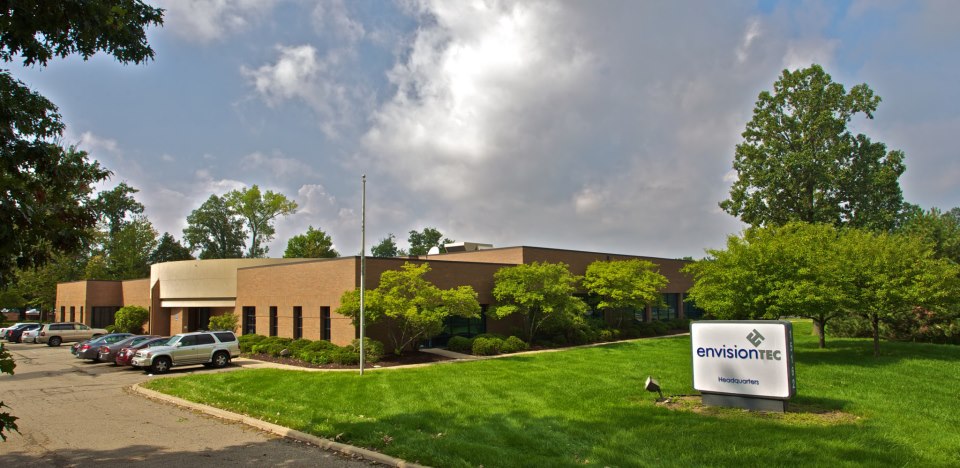While there are hundreds of companies betting on the future of 3D printing, with innovative ideas and a lot of passion, there are four companies that have spent the past two decades building the bases for this future to exist and are going to continue to build on it. These Fab Four of 3D printing cover just about the entire spectrum of commercially viable materials and processes. One is EnvisionTEC, the number one patent holder for all that is DLP and 3SP technology, and the originator of commercial DLP 3D printers.
Recently, circumstances brought me to have the opportunity to speak with Mr. Al Siblani, founder and CEO of EnvisionTEC, who is recognized in the entire industry for his creative vision and is definitely the only person that can help me put into perspective all that is happening in the DLP area, with low-cost machines running wild, a software company like Autodesk releasing its Ember 3D printer, Carbon3D making incredible promises and, yet, EnvisionTEC is doubling its global production capacity. Not to mention that the company is one of the most successful to date in the bioprinter segment, as well.
All discussions on Carbon3D need to start from one very important premise. This premise has a name and number: US Patent 7892474 B2, “Continuous generative process for producing a three-dimensional object”. In my journalistic ignorance, I had, in the past, manifested stupor as to why EnvisionTEC had never developed continuous DLP technology. Fortunately, this time around, I did a little more research and found that, naturally, they have. And they filed a patent for it in 2006. When I asked Mr. Siblani about Carbon3D, he made it clear that he and EnvisionTEC “are keeping a very close eye on how it will all develop“. However, he did not deny the fact that their R&D team is very intimate, and involved in continuous DLP printing.
Considerations become more critical when discussing other possible competitors to EnvisionTEC’s photopolymer-based 3D printing. Mr Siblani feels that France-based Prodways’ technology is an interesting one, but questions the build speeds and productivity of their machines when competing in the large frame industrial sector, and that smaller companies, such as Italy’s DWS, lack the capacity to successfully scale up operations. He is – somewhat understandably – even more critical when discussing Autodesk’s decision to entirely open source its photo chemistry for the Ember DLP 3D printer, arguing that some of the processes involved in the chemical mixing of photopolymers should be deemed unsafe for consumers to practice.
Guaranteed professional-grade, top-quality 3D printers; a wide range of high-end, market-specific materials; and standardized performances are among the reasons why, in spite of all the new DLP machines hitting the market, EnvisionTEC is growing like never before. “Both the manufacturing plants in California and in Germany have doubled their production capacity over the past year,” Mr. Siblani revealed.
EnvisionTEC’s strategy is far from building an ecosystem, but is, instead, more focused on delivering end-to-end solutions through integration with other partners. “We do not want to be the 3D printing company that offers everything to everyone. We will continue to focus on delivering 3D printing solutions to verticals with high value add,” he said.

Two of the Fab Four have been getting hammered lately on the stock market – which Mr. Siblani feels to have been overly punishing on the other public companies in the space – but the financial markets just cannot seem to want to wait to get a piece of the two privately held ones: EOS and EnvisionTEC. On that regard, EnvisionTEC’s CEO explained that the company “will explore all financial equity opportunities that will allow it to grow both organically and inorganically.” This is, by far, not an admission that the company is thinking about an IPO. However, I believe that it does not rule out the possibility.
One sector that does not seem to know any crisis is that of bioprinting. EnvisionTEC has been the only large 3D printer manufacturer to invest directly in the development of a bioprinter and its 3D-Bioplotter is now possibly the top selling system worldwide, especially the lower priced Developer Series targeted at Universities.
“Our first investments in bioprinting date back to the early 2000’s, when we developed our first generation bioplotter”, Mr. Siblani revealed. “We have been working and optimizing the machine for the past 15 years, meeting the demands of research institutions and universities worldwide and we are currently selling the fourth generation. Lately, more and more companies are getting closer to possible commercially viable applications and this trend can only grow in the future.” One thing that is clear is that more scientific papers are published in the bioprinting space utilizing the 3D-BioPlotter from EnvisionTEC than any other system.
While the fact that the market is opening up to so many different approaches is incredibly fascinating, especially from a journalistic point of view, however real industrial dynamics are very different. Last week, Stratasys successfully defended portions of its FDM patent and the same is bound to happen for many of EnvisionTEC’s own intellectual property portfolio, if that ever challenged its business growth. This does not seem to hinder the industry’s general growth and I remain convinced that bottom-led innovation needs to coexist and collaborate with top-led innovation in 3D printing, even if the approaches follow different market logics, to the benefit of the entire industry.




